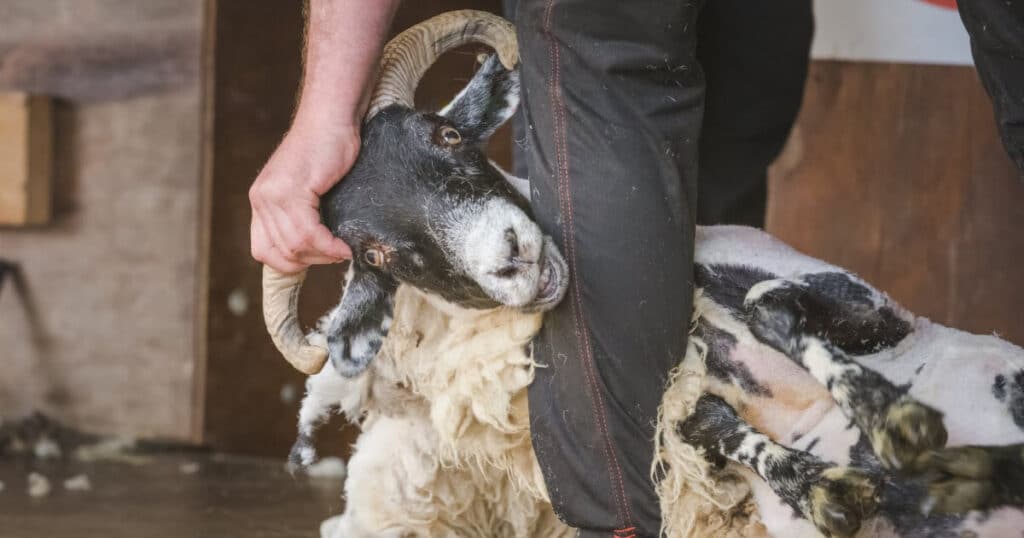While most sheep are sheared annually in the spring, some long wool breeds may need shearing twice a year. There are other considerations that come into play, too. So, the answer to the question how often are sheep sheared varies from farm to farm. Keep reading to find our complete guide to how often sheep are sheared.
If a sheep is sheared twice a year, the wool will have a shorter staple length. However, some farmers choose to do this because the ewes have shorter wool at the time of lambing and take up less space at the feeder during the winter months.
When Are Sheep Sheared?
Most sheep farmers shear their sheep during the spring. This makes sure that the sheep will still have all their wool during the cold weather of winter but are shorn and cool for the heat of summer.
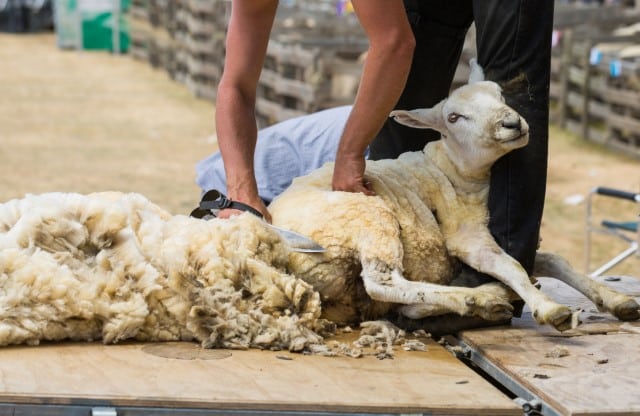
It’s also common on some farms to shear ewes before lambing time. This is because of how wool quality declines during lactation.
Also, having freshly shorn ewes allows young lambs to find the teat more easily as they’re learning to nurse.
And shearing before lambing means that the lambs will be born in a cleaner environment.
March is often the month when shearing begins. You’ll want to think about when you expect lambing to happen, and plan your shearing date accordingly.
It can be helpful to shear pregnant ewes approximately one month prior to lambing. This makes the ewes more likely to find shelter before the lambs are born, and if you (or the person you hire to shear your ewes) is skilled and gentle, there is a low risk of impact on the pregnancy.
Why Do We Shear Sheep Every Year?
With most breeds, sheep are usually shorn once a year. Spring is the most popular time of year for shearing sheep.
Sheep wool never stops growing and (hair sheep aside) these animals never shed. If you didn’t shear your sheep, the animals would end up extremely uncomfortable and could even end up with skin irritation and infections. Of course, they may lead to other health conditions, potentially dangerous.
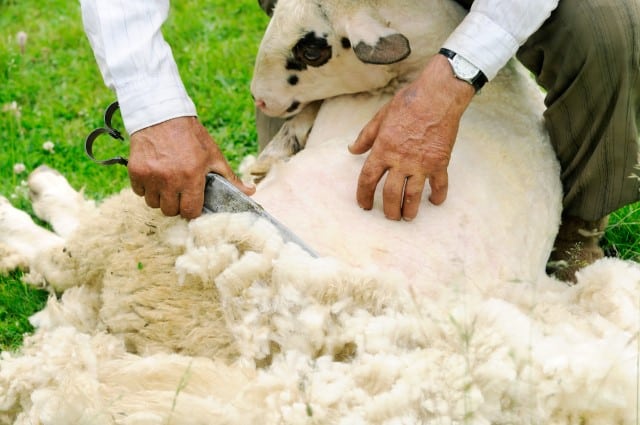
Sheep not shorn before the summer will have difficulty dealing with the heat. Also, wool that is allowed to grow too long is also likely to get dirty and full of tangles.
How are Sheep Sheared?
Farmers usually hire professionals to shear their sheep. I have a guide explaining how to shear sheep if you’d like to learn about shearing.
Sheep shearing is a challenging and labor-intensive task, and it takes quite a bit of skill.
Speaking from my 20+ years of experience raising sheep, I put it in the “easy to learn, difficult to master” category.
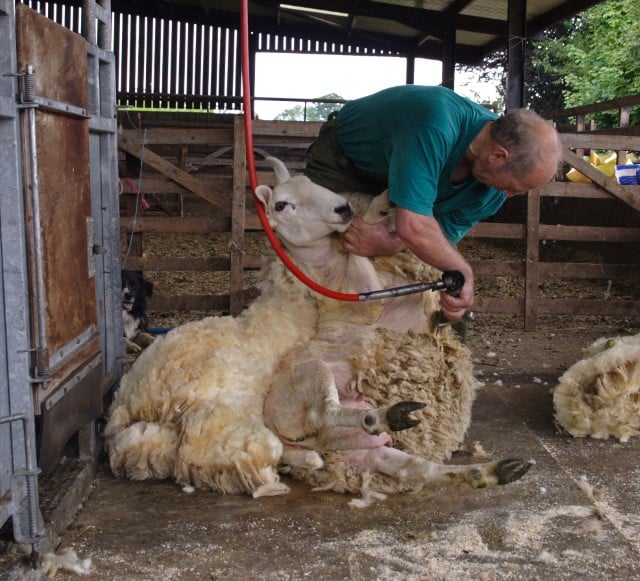
If an inexperienced person tries to shear a sheep, they could end up hurting the sheep or themselves. It’s important to learn the proper technique.
Shearers usually use shearing machines and electric shears when shearing sheep.
A skilled shearer will make sure the wool is kept in one piece (called a fleece) during the whole process, trying to avoid second cuts so the fleece has a full and uniform staple length (the length of the wool fiber from tip to where it is shorn).
If you aren’t sure what to do and take multiple passes through the wool, you’ll end up with a lot of waste during the wool skirting process.
How to Get Sheep and Your Operation Ready for Shearing?
You will have to start getting your sheep ready for shearing between 30 and 60 days before you plan to shear them.
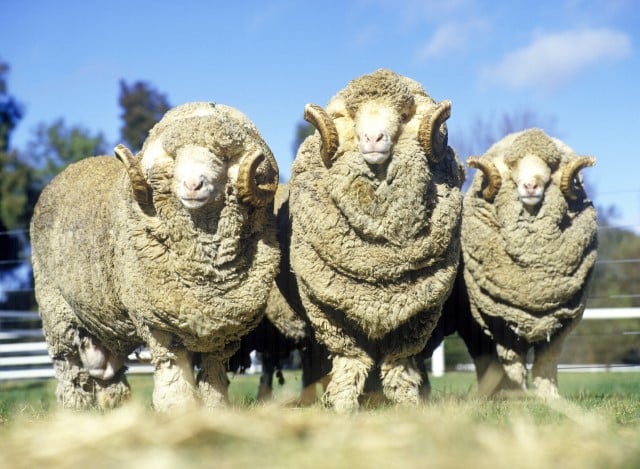
First, choose a shearing date. Think about when lambing will occur and other factors before making a decision on this.
In most cases, it’s best to shear your ewes 30 days or more before you expect them to lamb.
If you’re like most farmers and you are going to hire a professional shearer, find out about their availability. At this point, also make sure you have a large enough supply of wool bags.
These must be at hand during shearing, or you won’t have anywhere to put the wool.
Ensure the animals don’t get damp or wet for two days before you plan to shear them.
How to Prepare for Shearing Day on Your Farm?
Prepare the area where you plan to do the shearing at least one week (and preferably a longer period of time) before you plan to shear the sheep.
You may need to build a new shearing floor. If you’re going to hire a professional shearer, ask him or her what kind of floor they prefer.
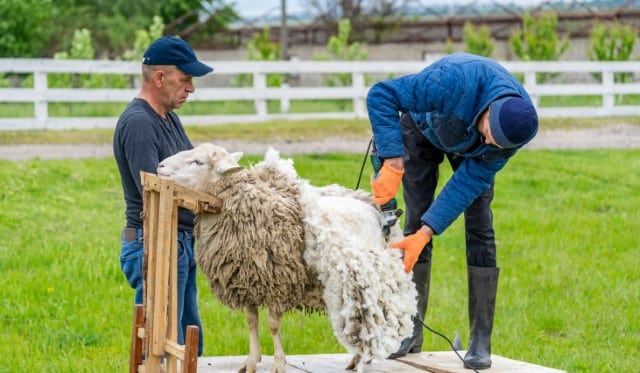
In many cases, they will want a raised floor above the primary one.
On our farm, we found that a clean 4×8 sheet of plywood, set on our barn’s concrete floor was adequate. It was easy to sweep clean between animals, and made collecting the fleece of each sheep easy.
At this point, there are a couple of other tasks that you will have to accomplish. For example, consider what will be the holding space for the sheep that are going to be sheared.
Also, make sure you have all the first aid supplies that might be needed if sheep are inadvertently injured. Blu-Kote is my go-to.
Make sure your sheep don’t get wet for one week before you plan to shear them. There’s always the chance of rain, so make sure there’s no risk your sheep will be outside when the weather gets wet.
Consider where your sheep are located inside. Make sure the location isn’t damp.
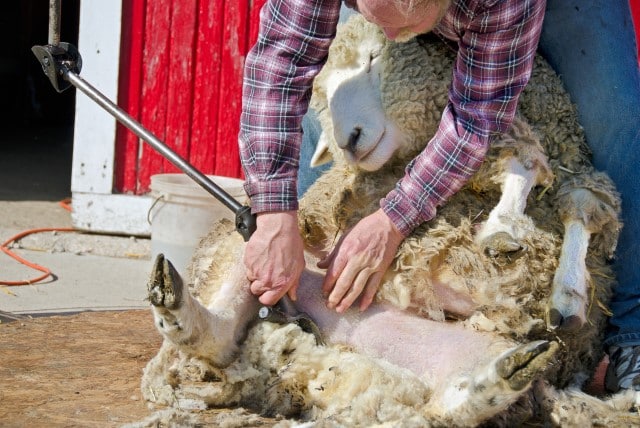
You should also check the ventilation, to ensure it’s efficient.
Once you get to two days before shearing, check to see if your sheep are completely dry. If they’re not, you will have to call off your shearing plans.
Look at forecasts for the day of shearing, and talk to your shearer about arrangements. Make plans about whether you will need to separate the sheep into different groups based on factors such as wool color and age.
The Day Before Shearing
Don’t let the sheep eat any feed (including grain and hay) for a minimum of 12 hours before you plan to shear them. This means that if you have any sheep on pasture, you will have to take them away from that area.
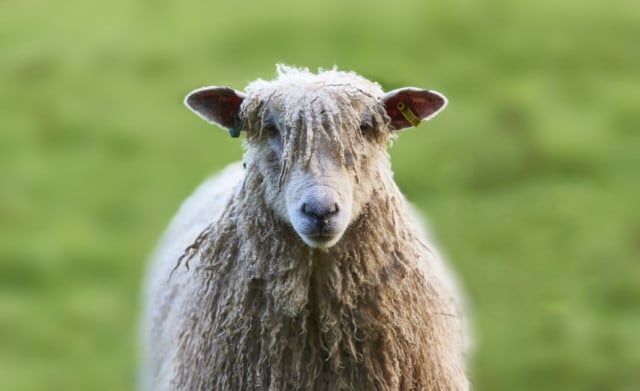
Once you get to shearing day, carefully check the equipment that the shearer brings to your property.
Verify its cleanliness and the fact that it has been disinfected. Disinfect the equipment again if necessary.
Always keep a close eye on sheep after they have been sheared, just in case they may have any injuries. If you notice any abscesses, treat them immediately.
Contact a veterinarian to take any further steps.
Shearing day is also a good time to trim sheep hooves.
On our farm we like to have a system where one person catches the sheep and is ready to hand the animal off to the shearer, and another takes the shorn animal from the shearer. This minimizes his or her downtime and allows them to work quickly.
After sheep are shorn, we trim their hooves before releasing them into the pen or paddock. Depending upon the stage of pregnancy and/or lactation, you may choose to deworm the sheep at this time as well before releasing them.
You don’t want to de-worm ewes in the first trimester of pregnancy, or while lactating. I like to do it about a month before delivery and after weaning their lambs, but consult the directions of the product you are going to use for guidance.
Long Wool Breeds
As mentioned earlier, certain kinds of long wool sheep may be shorn twice each year. If you have long wool sheep breeds on your farm, you may choose to bring them through the shearing process twice each year. The staple length of the wool may be shorter, but the quality and total annual yield may be improved if you take this approach.
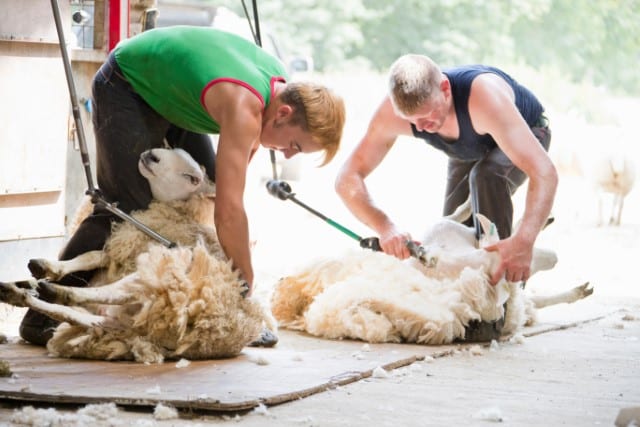
In most cases, however, once a year is enough. It really depends on how you plan to use the wool.
If you have long wool sheep, you’ll have a find a shearer with experience shearing these animals. Preferably, look for a shearer with a specialty in long wool sheep.
This is usually a bit more expensive than shearing regular sheep, but it’s worth the price.
Now You Know How Often Sheep are Sheared
There are many reasons that sheep need to be sheared, including their own health and comfort.
At minimum, sheep farmers must shear their animals once a year. In some cases, though, they might decide that they have to do it twice a year.
You should shear your sheep in the spring. This will ensure they still have their full wool coats for the winter but will be cool for the summer. This strategy also creates a cleaner lambing environment.

